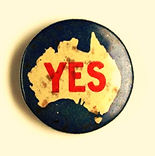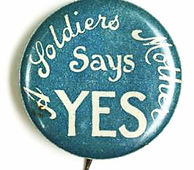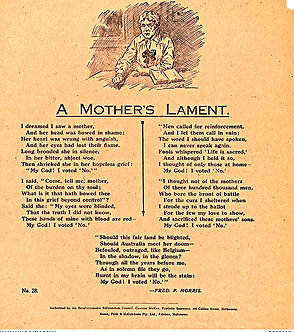The 1st Conscription Campaign, 1916
At the outbreak of war, the Prime Minister Andrew Fisher promised Australia would support Britian to the 'last man and last shilling'. It was an extremely ambitious target for a young nation which relied on voluntary enlistment. The government's ambitious goals meant women came to play an important role in encouraging enlistment.
At the end of 1914, 50,000 men had enlisted for the Australian Imperial Force, but the numbers began dropping in1915. The Gallipoli landing and actions reversed the trend and enlistment rates again increased.
The new Prime Minister, William 'Billy' Hughes, was recognised for his strong support of the war effort. Having visited the Western Front, Hughes believed conscription was necessary and that military service was a moral duty of the men of Australia.
Even before Hughes proposed conscription, peace activitists were active in condemning its potential future introduction. Vida Goldstein of the Australian Peace Alliance warned of the dangers of conscription in 1915 to large public meetings.
"..she was opposed to conscription and every form of militarism. She objected to sending boys who ought to be in the school room to the war. The first line of defence, she said, should be the politiciains who created the war, and the second line should be the newspaper editors and the clergy. (Applause.)...She might be called a pro-German, but she was not afraid to say what she thought...People in Australia said there was no need to oppose conscription, because it would never be introduced; so long as the Labour party was in power; but the Labour Ministry was not free. It took its orders fromthe British authorities...Conscription was undemocratic and unnatural. War should be fought by those with incomes over 300 pounds a year..."
The Argus, September 22, 1915, p. 9
With the heavy losses of the Gallipoli campaign and the slowing enlistment rate, Hughes decided to hold a referendum in October 1916, to directly ask the people of Australia to agree to sending conscripts overseas, to ensure that the Australian Divisions were kept at full strength.
The campaign that ensued divided Australia in a way that had never happened before. Some people strongly favoured conscription, others were vehemently opposed to conscription but no-one sat on the fence! It was a bitter and acrimonious time, an atmosphere savoured by the Prime Minister.
Women played an important role on both sides of the campaign, conducted between September and December 1916. They addressed public meetings, sometimes facing raucous and violent opponents, organized pamphlets and marches and featured heavily in propaganda posters. Despite being jostled and harassed, forcibly removed from speaking platforms and pelted with stones, women continued to be important speakers and advocates all over Australia.
On the pro-conscription side, many women believed that they were protecting the men already at the front by providing adequate reinforcements and that this would make Allied victory more easily achieved. On the anti-conscription side, many women believed that they were saving lives by not sending men to war and that the issue of compulsion was something that Australians should avoid at all costs.
Like the rest of Australia, the troops overseas were divided on conscription. In letters home some men rejected the idea of being joined in war by ‘jellyfish’ while others felt it was unfair that 'shirkers' were not bearing their fair share.
The first referendum was narrowly defeated 51% to 49%. The votes of the Diggers showed support for conscription but only by a slim margin.
Create a poster (either written or visual or a mixture of both) which expresses your own perspective.
Many of the women who were active in the consciption debate were aligned with various organizations.
On the anti-conscription side these organizations included the Women’s Peace Army (WPA) led by Vida Goldstein whose slogan was "We war against war", the Quakers, a religious group which included Margaret Thorp and the Women's Christian Temperance Union whose President was Cecilia Downing. Other prominent anti-conscription activitists included Adela Pankhurst, Jennie Baines, Alice Souter/Suter, Elizabeth Ahern, Emma Edwards and Alice Warburton.
The anti-conscription campaign also included women who worked for the No Conscription Fellowship, the Australian Women’s National League (AWNL), the No Conscription Council, the White Feather League and the Anti-Compulsory Service League.
The pro-conscription side included Lady Helen Munro Ferguson of the Australian Red Cross as well as Eva Hughes, head of the Australian Women’s National League and was supported by the press.
Select one organization or one woman activist and research its/her contribution to the campaign on consciption. Write 2 paragraphs, the first paragraph providing biographical information and the second explaining its/her importance.
The 2nd conscription campaign, 1917
Hughes’ support of conscription in 1916 put him at odds with his own party, the Australian Labor Party. He left the ALP and formed a new party, the Nationalists, which won the 1917 federal election. His major focus remained the war and the need to increase the number of reinforcements.
Many working class women believed that the defeat of the first conscription campaign had so offended and upset Billy Hughes personally, that he decided seek revenge against the Labor Party supporters who had not supported the introduction of conscription. During the very cold winter of 1917, the government’s decision not to address the very high prices for basic necessities for food and heating as well as the high unemployment rate was seen as a deliberate move by Hughes to force men to enlist.
A major industrial dispute became a general strike, spreading from timber and railway workers to coal miners and other industries and became an ugly confrontation involving thousands of people in mass demonstrations. Between August and October 1917 hundreds of middle class women, including the world famous opera singer Nellie Melba (aged in her mid 50s), stepped in and volunteered to take over the work of strikers, becoming strike breakers or "scabs". Some women were driven by financial need but most chose to do so because they believed that the labour movement, at a time of national crisis, was turning its back on Australia and that Australians should support the soldiers and the war effort.
The role of "scabs" caused great anger amongst working class women and resulted in large demonstrations dominated by women. As a result, many of these working class involved themselves in the second conscription campaign, but they faced considerable disruption from soldiers who attempted to disrupt anti-conscription meetings and demonstrations.
The second conscription campaign was similar to the previous campaign in that women again were active as meeting organizers and speakers on both sides of the debate. They were also directly targeted by both sides using propaganda posters, leaflets and flyers. The nature of the campaign literature in all its forms became more virilent and class divisions became especially divisive. ‘Billy’ Hughes continued to be a powerful advocate for the pro-conscription case, while Vida Goldstein continued in her energetic role as a representative of the Women’s Peace Alliance.
The second referendum was defeated by an even wider margin than in 1916. Australian troops again supported conscription but by an even narrower margin than in 1916.
Conscription refers to compulsory military service for action overseas.









"Send out the boys of the devil's brigade,
They'll keep Australia free:
Send out my mother, my brother, my sister,
But for God's sake don't send me."
Satirical comment on the motives of their opponents by pro-conscriptionists, Argus, Tuesday, December 4, 1917

Using Sources
-
What do the pro- and anti-consciption sources tell us about the nature of Australian society in 1916 and 1917?
Write a letter to the editor of the Sydney Morning Herald, expressing your view about whether Australia should introduce conscription. Your letter should make reference to some specific aspect of the war and may refer to the first conscription campaign in 1916. The letter should be no more than 300 words.
-
Examine any 2 cartoons, but one from the pro-conscription campaign and one from the anti-conscription campaign.
-
Who produced the Source?
-
When was the Source produced?
-
What does the Source show about conscription?
-
What is the perspective of the Source?
-
Do you notice any differences in the sources from 1916 and 1917? Explain why they are different.
Class meeting
Come to a decision about which side of the campaign you might have supported during World War I and prepare a list of reasons to justify your perspective. Be ready to take an active part in a class meeting. Several roles need to be filled: Chairman, Pro-conscription advocates, Anti-conscription advocates, interjectors for both sides and audience.


























